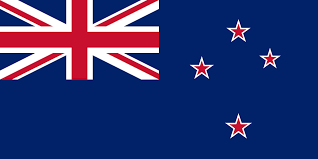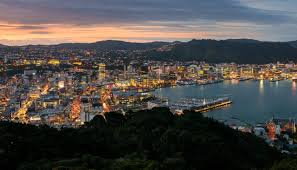New Zealand has the nickname of Aotearoa , a word that means “land of the great white cloud”. This small country, located on the continent of Oceania and considered the brother of Australia, has only 4.5 million inhabitants, spread over this small large island.

The English language is the official language spoken in the country because for a long time, as with Australia, New Zealand was colonized by the British and, for this reason, they maintained many of their habits after independence.
Those who live in New Zealand , in addition to enjoying the benefits of living among the country’s natural beauty, can also enjoy the best quality of life on the planet – in addition to being able to learn to speak Maori, the other official language in the region.
New Zealand is a country formed by a group of islands in the southern part of the Pacific Ocean, in Oceania. The Maori had been there for centuries when Europeans arrived in the 17th century. The capital of New Zealand is Wellington. The country has 4,474,000 inhabitants (2014 estimate) and its area is 270,692 km2.

The New Zealand Flag has the same colors as the United Kingdom flag , blue , red and white , in addition to the reproduction of this flag in its upper left corner, in reference to British colonization. In addition, it presents 4 red stars with white borders , which represent Cruzeiro do Sul , a constellation that can only be seen in the sky of the southern hemisphere, where the country is located. The flag has never been changed since the country became independent from the United Kingdom in 1931.

The capital of NZ is the city of Wellington, which is located in the south of the country, but its most popular city is Auckland, where about one and a half million inhabitants live.

NZ is remembered for being the country of extreme sports – like bungee jumping and rafting – but also for being the land of Rugby and, therefore, the national team, the All Blacks, are the pride of the nation and one of the most strongest in the world.
North Island

This is the island that houses the New Zealand capital, Wellington. It is also the island with the largest city in the country, the famous Auckland .
Another highlight of the region is Rotoura , a city famous for its geothermal activities, which result in hot springs, mud pools and much about Maori culture.
Bay of Islands is also another must-see place while visiting New Zealand. With a breathtaking view, it is one of the most visited places in the region.
South Island

If you’ve seen the classic “The Lord of the Rings”, you’re sure to be familiar with New Zealand’s southern island. The saga was recorded in the region due to its stunning natural beauty.
The South Island also has the sports capital, Queenstown . There, you will find several types of radical attractions, such as bungee jump and the steepest cable car in the southern hemisphere.
Another must-see on the South Island is the Abel Tasman National Park , perfect for kayaking or sailing. You can still see dolphins and seals there.
All about New Zealand: Strong local economy
Despite not having such a popular currency in the world economic market, NZ has one of the most stable economies in the world, a situation that is extremely comfortable for those who live in the country, but also for those who choose to visit it.
One of the strengths of the country’s economy is even tourism, which is a practice encouraged and valued by all New Zealanders for bringing good results to the region.
NZ is one of the favorite destinations for exchange students who want to take advantage of their study period to also make some money and live a professional experience abroad.
Since 2014 the rules of study and work in the country have changed and, for any student who enrolls in language courses over 14 weeks in duration, it is already possible to embark to the country with an authorization to work there.
The work can last 20 hours per week and the contract will only last for the period the student is in the country.
For courses that go beyond 12 months, students can also work full time during the holidays. It is necessary, for both cases, to obtain a work visa to be able to act legally in the country.
For Brazilians, New Zealand is a very pleasant destination to live. In the north, the climate is subtropical, while in the south, temperate.
In addition to the favorable climate , the New Zealander people are known for their great receptivity to foreigners, tourists and exchange students and, therefore, it is natural to feel welcomed and at home there.
The level of adaptation of Brazilians who travel to the country is relatively high, when compared to other destinations.
Flora and fauna
European colonists destroyed many of the native perennial forests. In the 20th century, New Zealanders started planting pine trees, forming new forests.
Among the animals that make up the native fauna are some reptiles, frogs and bats. The first occupants of the land, the Maori, took dogs and rats to the islands. Europeans later took red deer, rabbits and skunks.
There are several species of non-flying birds in the country, such as tacaes, penguins and kiwis. Kiwi is the national symbol of New Zealand.
Population
The majority of the population is of European descent. About 10 percent of New Zealanders have Maori ancestors. Other ethnic groups include Asians and people from other islands in the Pacific. English and Maori are the official languages. More than half of the population is Christian. Most New Zealanders live in cities, mainly on the North Island.
Economy
Although agriculture is one of the most important activities in New Zealand’s economy, only a small part of the population is dedicated to it. In the country apples, barley, wheat and corn are grown. In addition to cattle, sheep are raised. Fishing and logging are also important in the economy. New Zealand sells wool, dairy, meat, fish, wood and paper to other countries.
In addition to food and wood products, the New Zealand industry also manufactures clothing and machinery. The country has iron ore and gold, as well as coal, limestone and natural gas reserves. Most of the population works in the provision of services, especially in the banking, insurance and tourism sectors.
History
The Maori arrived in New Zealand from the islands of Polynesia, a region in the south-east Pacific, probably around 800.
Contact with Europeans
In 1642, a Dutch navigator spotted New Zealand, but did not land there. It was the British explorer James Cook who landed on the islands in 1769. Whale and seal hunters were not long in coming.
In 1840, the British imposed their sovereignty on the Maori, promising to protect their rights over the land. However, the colonizers soon demanded that the Maori give them up or sell them. The British and the Maori fought each other until the 1870s. As a result, the Maori lost most of their best land.
Links with the British
In 1907, New Zealand became an independent state within the British Empire and, in 1947, it achieved complete independence. The country is a member of the British Commonwealth, a group of countries made up almost entirely of former colonies in the United Kingdom.
New Zealand today
Between the end of the 20th century and the beginning of the 21st, there was growth in the country’s trade relations with Australia, with other Pacific countries and with the United States. In addition, the government began to return some land to the Maori.
In 2010, the country’s second largest city, Christchurch, was hit by a strong earthquake. Many buildings were damaged, but no one died. Several aftershocks (that is, minor earthquakes that occur after the main earthquake) continued to hit the city for a few months. The largest of all, in February 2011, was more serious than the original earthquake, killing more than 150 people and destroying several buildings.
